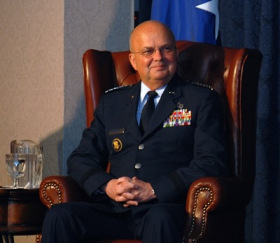2008-09-17
Maximilian Forte -
As if to continue a previous post here titled, “Imperializing Open Access and Militarizing Open Source: “What’s yours is ours. What’s ours is ours” (1.3),” we can see that others, including Noah Schachtman below, are beginning to realize the situation that open access publishing has to face in this “era” of a U.S. “global” war “on terror”. For those of us who have advocated for open access publishing in anthropology, these realizations ought to be sobering at least, and should compel us to rethink our role in possibly supporting U.S. imperialism, specifically its military and intelligence arms, now that this is war has gone well beyond the confines of targeting one single organization. When placing material out in the open, we should not be “dumb” (Hayden’s word below), and train ourselves to “see like a state.” In the passages that follow, key sections appear in bold:
From Noah Schachtman
DANGER ROOM, Wired Blogs, Sept. 17, 2008
 The material is out in the public sphere, for anyone to see: newspapers, television shows, Internet postings. The methods for obtaining the material are straight-ahead: watch the tube, click on a mouse, and translate accordingly. The end product is almost always unclassified. And the whole thing is paid for by U.S. taxpayers. But the head of the CIA says that average Americans shouldn’t be able to see so-called “open source intelligence” products. It’s too sensitive for public eyes.
The material is out in the public sphere, for anyone to see: newspapers, television shows, Internet postings. The methods for obtaining the material are straight-ahead: watch the tube, click on a mouse, and translate accordingly. The end product is almost always unclassified. And the whole thing is paid for by U.S. taxpayers. But the head of the CIA says that average Americans shouldn’t be able to see so-called “open source intelligence” products. It’s too sensitive for public eyes.
Director of National Intelligence Open Source Conference late last week. (Click here for the audio.) “One irony of working the open source side of the intelligence business… is that the better we do, the less we can talk about it.”
Just a few years ago, open source intelligence was a backwater in a community where wiretaps and surveillance satellites and clandestine agents were prized. But that’s changed, of late. The head of the Open Source Center, where public information is collected, now reports directly to Hayden – just like the Directorate of Intelligence and National Clandestine Services chiefs. Open source material is included regularly in the President’s Daily Brief – the intelligence summary, delivered right to the Oval Office.
These days, “secret information isn’t always the brass ring in our profession,” Hayden said. “In fact, there’s a real satisfaction in solving a problem or answering a tough question with information that someone was dumb enough to leave out in the open.”
He added, “The questions our customers ask – whether it’s a policy maker or a military commander or a law enforcement official — demand answers, many of which are only available through open source research.”
Open source material not only fills in blanks often-elusive adversaries. It can also give a broader sense of the mood in a particular country, or the feeling in a particular group. Hayden himself found this out recently in Key West, Florida. At a CIA listening station, he watched a Cuban soap opera, where they joked constantly about the Castro regime Keystone Kops approach to domestic surveillance. “It gave me a new appreciation for life and thought on the island,” Hayden said.
But, by the end of his talk, it still wasn’t clear is why the rest of us couldn’t enjoy that same appreciation.
Source: http://zeroanthropology.net/2008/09/17/more-on-us-militarization-of-open-access/






 ON MAY 20, 1997, CLEMENTE BANUELOS, A U.S. MARINE ON AN ANTIDRUG operation, shot and killed 18-year-old Esequiel Hernandez, Jr., in Redford, Texas. Banuelos was a member of Joint Task Force-6 (JTF-6), a federal agency that coordinates antinarcotics operations between the Border Patrol and the military. Although Border Patrol and Marine officials claimed that Hernandez shot at the Marine surveillance team, an autopsy report suggests that Hernandez could not have done so. Banuelos' attorney stated that while Hernandez had no previous criminal history, he fit the profile of a drug trafficker that was given to the marines in their training for missions on the border (Los Angeles Times, 1997). Meanwhile, government officials described the killing as an unfortunate, but justified act of self-defense. "This was in strict compliance with the rules of engagement," said Marine Col. Thomas R. Kelly, deputy commander of the military's anti-drug task force (Katz, 1997: A19).
ON MAY 20, 1997, CLEMENTE BANUELOS, A U.S. MARINE ON AN ANTIDRUG operation, shot and killed 18-year-old Esequiel Hernandez, Jr., in Redford, Texas. Banuelos was a member of Joint Task Force-6 (JTF-6), a federal agency that coordinates antinarcotics operations between the Border Patrol and the military. Although Border Patrol and Marine officials claimed that Hernandez shot at the Marine surveillance team, an autopsy report suggests that Hernandez could not have done so. Banuelos' attorney stated that while Hernandez had no previous criminal history, he fit the profile of a drug trafficker that was given to the marines in their training for missions on the border (Los Angeles Times, 1997). Meanwhile, government officials described the killing as an unfortunate, but justified act of self-defense. "This was in strict compliance with the rules of engagement," said Marine Col. Thomas R. Kelly, deputy commander of the military's anti-drug task force (Katz, 1997: A19).




